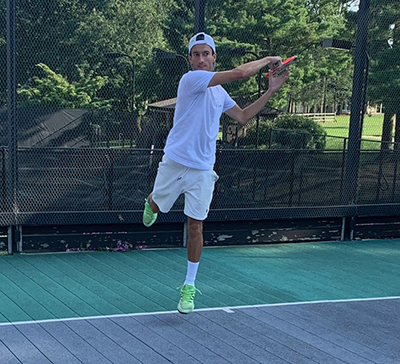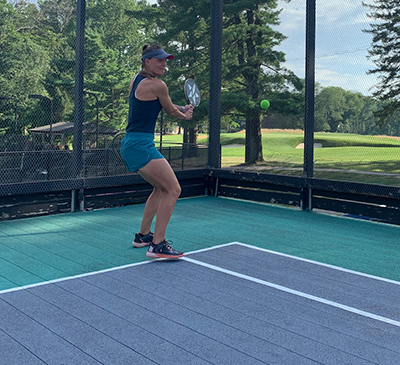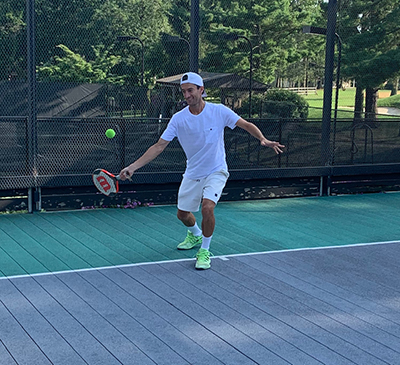Thinking Like a Pro
August 1, 2022
Coaches Corner

By Oliver Jones
He teaches paddle and tennis at The Overbrook Golf Club in Villanova, PA.
Oliver holds a 9.3 PTI and competes nationally on the APTA tournament circuit with partner Jody Sambrick.
In this series Thinking Like a Pro, we are contrasting the mental approach of the professional paddle player to that of the amateur or recreational club player. (If you want to dip your toes into what the pros are doing and make the move from standard to great, these articles can help to get you there.) By highlighting the differences, we will begin to get a clear view of a pro’s thought process. A mindset that gives him the opportunity to advance his physical and mental limits and edge closer to his full potential.
While we will be thinking within a platform tennis context, these concepts emphasize underlying mental models for learning, and thus undoubtedly apply in all areas of life in which we seek true mastery. Each article in the series we will examine one specific area; in this first article we are investigating focus.
FOCUS ON THE FIRST THING
The professional takes his long-term vision and breaks it down into smaller, clearly identifiable steps, until he arrives at the first thing to do to advance to the next step in the sequence. He then focuses his attention entirely on this step, as it is the first and must be addressed before any subsequent steps. In this way the professional makes decisions. He makes clear, accountable, considered choices about what he wants to achieve, why he wants to achieve it, what it’s going to take to get there, and the necessary steps to accomplish it.
Conversely, the amateur gets distracted. His attention drifts from one task to another with no consideration of the sequence of his attention, and his performance is reflective of this lack of focus. Due to this lack of structure, the amateur often perceives tasks as overly complex, whereas the professional, having broken it down into its individual steps, sees simplicity and clarity, often focusing on fundamentals.
The amateur will be prone to basic mistakes and prone to deviating erratically off course from the trajectory he wants to go. He will often suffer from compromised, variable, directionless behavior and decision making. This makes it difficult for the amateur to see where he went wrong; without a framework he cannot identify where and what broke down.
Because the professional has a clear sequential structure to his actions, he can more easily identify mistakes quickly and efficiently, allowing him to rectify the error immediately and get right back onto the next step in the sequence.
The amateur solves the symptom, the professional solves the problem. The amateur will look at a poor result and be quick to focus on trying to change the outcome. The professional, knowing that results are the consequence of actions, lays their attention to the sequence of behaviors and choices that led to the outcome. If there was an error here, toward the root of the sequence, then that is the true systemic error that needs to be rectified. The professional understands that the first step is to investigate that there could be a base layer problem that needs to be solved versus simply looking at the result. A professional knows that without diagnosing this root error, the real mistake will go unaddressed, and thus, the objectionable outcome is doomed to future repetition.

HOW THIS WORKS IN PRACTICE
Let’s say I'm an advanced beginner club player and my ultimate goal is to have fun at social paddle events with my friends. To have fun I’d like to be relatively competitive, so that I can hold my own with the various skill levels I may face. Not necessarily to win, but to be comfortable on the court and not feel like I'm holding back any of the others. This will require some skills such as knowing the scoring system, knowing basic positioning, and having competence of some key shots (already, we are starting to break things down into components.) Let’s say I know the scoring and positioning already, then it makes sense to look at what’s next: the key shots I need. Initially, I’ll think about what shots I'm going to hit the most, as these shots will logically be the most important. The first three shots—serve, return, first volley—are the most meaningful shots in paddle, so naturally, I would draw my focus to this area.
Breaking these three shots into a hierarchy, we would say the serve is the most important. Clearly, if I can’t reliably make my first serve, I'm not going to have much success on the court, let alone give myself a chance at the next shot (and next step), a first volley. Plus, a reliable serve will give me a better chance to have a good time with my friends (ultimate goal), as I will be self-confident standing up to the baseline when it is my turn to deliver the first ball, which is quite often (every four games!). Having broken down the steps in this way, my priority will be to focus my practices before the event so that I have a reliable first serve.

WHAT IS MOST IMPORTANT
The great part about this systematic approach is that not only does it work across all levels, but also that we can always take it further if we are seeking even greater clarity. For example, now that I know my priority is the serve, I can break down the serve further into its constituent parts. To get a reliable serve, I need a reliable technique, a reliable toss, and a reliable contact. If I have all three, I have a reliable serve.
If I'm struggling with one out of the three, let’s say my toss is unreliable but I have decent mechanics and I can consistently make sweet-spot contact, then it’s the toss that becomes my first step. I would make sure to practice my toss until it is reliable, then I can progress to the next step in my priority sequence.
Finally, this mental approach also applies during the match itself. Keeping with our example that I'm at a social event, let’s say I’ve been paired up against the reigning club champs and it is my turn to serve. While this could seem like a lot of pressure, pressure comes from the mind (called ‘Future Projection’). The Focus on the First Thing process allows us to center the mind on the moment and what is most important. So, instead of thinking about what the club champions are going to think of me, or if the people in the hut are watching me, I settle my thoughts on the First Thing, my serve, and the steps I need to take to execute it.
The challenge is taking the time to acknowledge the ultimate objective. What comes next is simply breaking this goal down into smaller and smaller successive steps until we get to the first one—this reveals how I should spend my time to deliver the greatest return on investment. It also serves to give clear mini objectives that I can use as motivation along the journey and as checkpoints along the way so that I can track my progress.
To figure out what you need to work on, take a moment to consider what it is you’d like to achieve, then with the help of a coach or a friend, start to break it down until you get to the one thing that will get you to the next step in the sequence. A sequence of steps that progresses you on the journey toward your ultimate goal.








